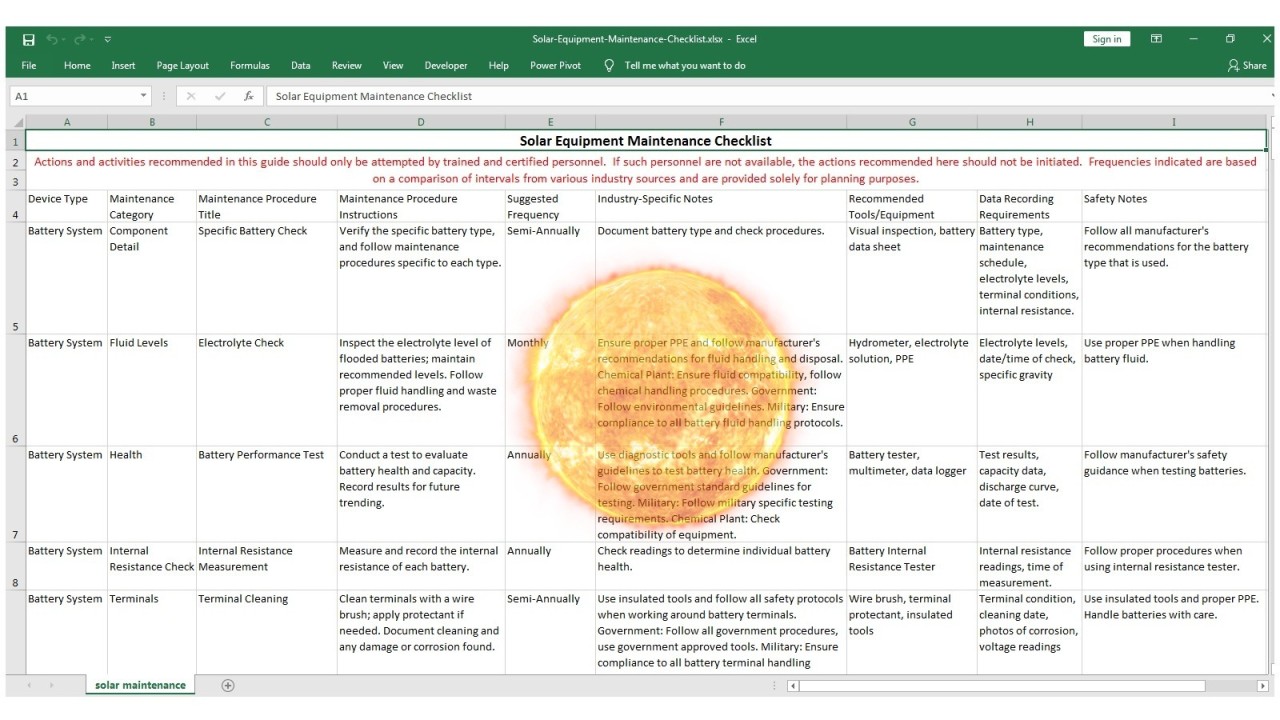This article delves into the critical aspects of solar panel maintenance, highlighting the
key areas that demand attention and offering a robust framework for ensuring your
system operates at its peak. We'll explore the benefits of a preventive maintenance (PM)
approach and introduce a comprehensive Solar Equipment Maintenance Checklist a
practical tool designed to streamline your maintenance efforts and protect your
investment.
Why is Solar Panel Maintenance So Important?
Several factors can impact the performance of your solar panel system over time.
Understanding these challenges is the first step in developing an effective maintenance
strategy:
- Soiling: Dust, pollen, bird droppings, and other debris accumulate on the surface
of solar panels, blocking sunlight and reducing energy production. The impact of
soiling can be substantial, with studies showing losses ranging from 5% to 25% in
some environments.
- Environmental Factors: Exposure to extreme weather conditions, such as heavy
snow, high winds, and hail, can cause physical damage to panels, mounting
structures, and wiring. Coastal environments pose a particular threat due to salt
corrosion.
- Component Degradation: Inverters, batteries, and other system components
gradually degrade over time due to normal wear and tear, temperature
fluctuations, and electrical stress. Regular inspections can identify early signs of
failure and prevent more serious problems.
- Wiring and Connection Issues: Loose connections, corroded terminals, and
damaged wiring can lead to power losses, electrical hazards, and system
downtime.
- Vegetation Overgrowth: Shading from trees and other vegetation can
significantly reduce solar panel output.
The Power of Preventive Maintenance
A proactive, preventive maintenance approach is the key to mitigating these risks and
maximizing the long-term benefits of your solar investment. Instead of waiting for
problems to arise, a PM program focuses on regular inspections, cleaning, testing, and
component replacements to identify and address potential issues before they escalate.
The benefits of a well-structured PM program are significant:
- Increased Energy Production: Regular cleaning and maintenance ensure that
panels receive maximum sunlight, leading to higher energy output and greater
savings on electricity bills.
- Extended System Lifespan: By addressing potential problems early, PM helps to
prevent costly repairs and extend the lifespan of your solar panel system.
- Improved System Reliability: Regular inspections and component testing
enhance system reliability, reducing the risk of unexpected downtime and lost
energy production.
- Enhanced Safety: Identifying and correcting electrical hazards and other safety
issues ensures the safety of your property and personnel.
- Maximized Return on Investment: By optimizing system performance and
extending its lifespan, PM maximizes the financial return on your solar
investment.
To help you implement a robust and effective PM program, we've developed a
comprehensive Solar Equipment Maintenance Checklist. This meticulously designed tool
provides a structured framework for conducting regular inspections and maintenance
tasks, ensuring that no critical area is overlooked. The checklist covers all major system
components, including:
- Solar Panels: Visual inspection for cracks, delamination, hot spots, and cell
damage; IV curve testing to assess performance; cleaning to remove soiling;
racking and mounting inspection for structural integrity.
- Inverter: Operational checks to verify proper output and charging settings;
ventilation checks to ensure adequate cooling; firmware update checks; error log
review; insulation resistance testing; wiring and connection inspection.
- Battery System (if applicable): Electrolyte level checks; battery performance
testing; internal resistance measurement; terminal cleaning and torque checks;
ventilation checks.
- Combiner Box: Fuse checks; surge protection device inspection; component
testing; diode testing; wiring inspection.
- Electrical Wiring: Conductor inspection; connector checks; weather seal
inspection; insulation resistance testing; voltage drop testing; conduit inspection.
- Monitoring System: Connectivity checks; data accuracy checks; sensor
calibration.
- Mounting System: Fastener checks; ground connection inspection; structural
integrity checks.
- Tracking System (if applicable): Tracker drive motor checks; lubrication checks;
mechanical checks; structural integrity checks.
- Transformer (if applicable): Ventilation checks; oil level checks; turn ratio test;
wiring and connection inspection.
- Grounding System: Ground conductor check, ground connection check, ground
resistance testing.
- Comprehensive Coverage: Addresses all major system components and
potential maintenance needs.
- Detailed Procedures: Provides clear and concise instructions for each
maintenance task.
- Suggested Frequencies: Recommends optimal maintenance intervals based on
industry best practices.
- Data Recording: Includes fields for documenting inspection results,
measurements, and maintenance actions.
- Tools and Equipment Requirements: Lists the necessary tools and equipment
for each task.
- Safety Notes: Highlights important safety precautions to protect personnel and
equipment.
- Customizable Format: The checklist is designed in Excel, allowing you to tailor it
to your specific system configuration and operational needs.
Who Should Use This Checklist?
Our Solar Equipment Maintenance Checklist is a valuable resource for a wide range of
stakeholders:
- Solar System Owners: Homeowners and business owners with solar panel
systems can use the checklist to perform basic maintenance tasks and identify
potential problems early.
- Solar Installers and Technicians: The checklist provides a standardized
framework for conducting comprehensive maintenance inspections and ensuring
that all critical areas are addressed.
- Facility Managers: Facility managers responsible for maintaining solar panel
systems on commercial properties can use the checklist to develop and
implement a robust PM program.
- O&M Providers: Operations and maintenance (O&M) providers can use the
checklist to streamline their maintenance services and deliver consistent, high-
quality results.
Take Control of Your Solar Investment Today
Investing in a solar panel system is a significant financial commitment. Protect that
investment and maximize its long-term value by implementing a robust preventive
maintenance program. Our comprehensive Solar Equipment Maintenance Checklist
provides the tools and guidance you need to ensure that your system operates at its
peak efficiency, delivering reliable and sustainable energy for years to come.
Ready to get started?
Click here to view our Solar Equipment Maintenance Checklist.
By prioritizing preventive maintenance, you can ensure that your solar panel system
continues to generate clean, affordable energy for decades, contributing to a more
sustainable future while reaping the full financial benefits of your investment.
